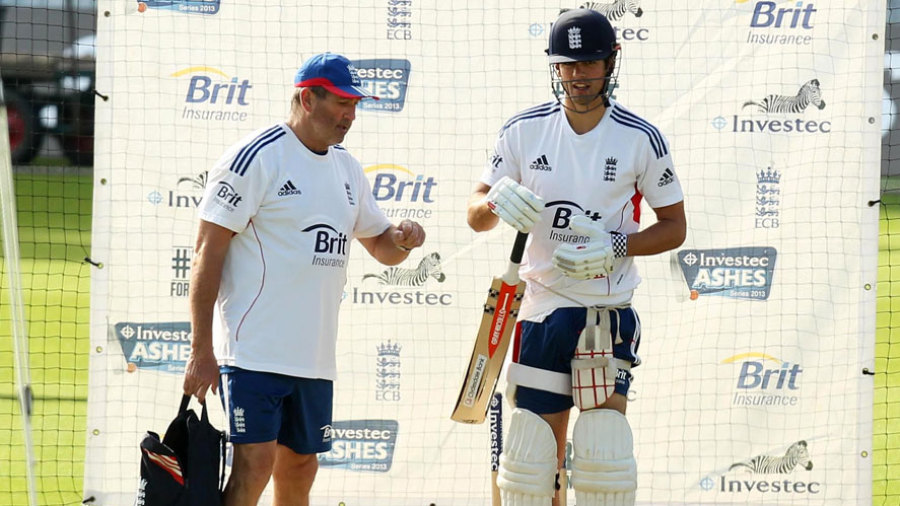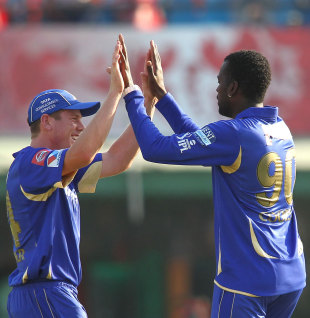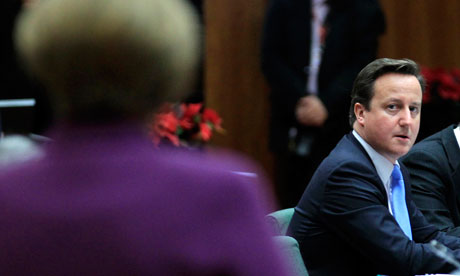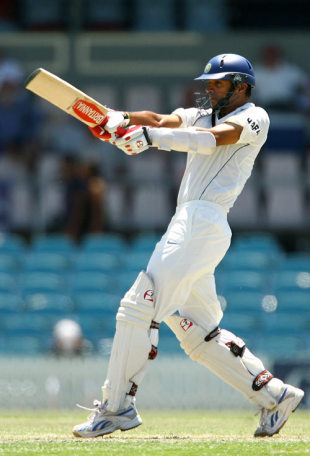Andy Bull in The Guardian
In July 2007, after a history reckoned to stretch back almost 4,000 years, the game of draughts was finally solved. After two decades of work, a team of computer scientists at the University of Alberta finished sifting through the 500 billion, billion possible positions on the board. Their computer programme, Chinook, was now unbeatable. So long as neither player made a mistake, every game it played was guaranteed to end in a stalemate. Later that same summer, Peter Moores was appointed as head coach of the England cricket team. Moores was one of the new breed of coaches. A numbers man, and disciple of Michael Lewis’s much abused book, Moneyball. He even gave a copy to his batting coach, Andy Flower. Moores was so keen on advanced computer analysis that he used it as the sole basis for some of his decisions – the decision to recall Ryan Sidebottom to the side, for instance.
When Flower took over the team, he hired Nathan Leamon, a qualified coach and a former maths teacher, as the team’s analyst. The players nicknamed Leamon “Numbers”. He was extraordinarily meticulous. He used Hawk-Eye to draw up spreadsheets of every single ball delivered in Test cricket in the preceding five years. He ran match simulations – accurate to within 5% – to help England determine their strategies and their team selections. For the bowlers, he broke the pitch down into 20 blocks, each of them 100cm by 15cm, and told them which ones they should hit to best exploit the weaknesses Hawk-Eye had revealed in the opposing batsmen. Bowlers should aim to hit that particular block at least twice an over. Do that, Leamon told them, and they would “markedly increases the chance of success”.
England, it was said, were making better use of the computer analysis than any other team in the world. And it was working. They won the World T20, the Ashes home and away, and became, for a time, the No1 team in all three formats of the game. Leamon’s work was picked out as one of the reasons why. And yet now they’re losing, that very same approach is being singled out as one of the things they are doing wrong. You can see why. After England’s nine-wicket defeat to Sri Lanka, Eoin Morgan said “Going in at the halfway I think we got 310, probably 25 for both par, and again, stats back that up, par is 275, 280.” It was, Morgan thought, the bowlers who were to blame for the loss. They had delivered too many bad balls. He said he didn’t yet know why. “Over the next couple of days, we will get the Hawk-Eye stuff back and the proof will be in that.”
On Tuesday morning, Kevin Pietersen tweeted that England “are “too interested in stats”. He was echoing Graeme Swann’s comments from last summer. “I’ve sat in these meetings for the last five years,” Swann said. “It was a statistics-based game. There was this crazy stat where if we get 239 – this was before the fielding restrictions changed a bit so it would be more now, I assume – we will win 72% of matches. The whole game was built upon having this many runs after this many overs, this many partnerships, doing this in the middle, working at 4.5 an over.” Swann said he was left shaking his head.
Two respected players, both speaking from fresh first-hand experience, agree that England have become too reliant on computer analysis to tell them what to do. But balance that against the irritation old pros in all sports feel about big data. Just last week the great blowhard of the NBA Charles Barkley unleashed this tirade: “All these guys who run organisations who talk about analytics, they all have one thing in common – they’re a bunch of guys who have never played the game, and they never got the girls in high school, and they just want to get in the game.” Analytics, Barkley added, were “just some crap that some people who were really smart made up to try and get in the game”.
Barkley was shot down in flames. As Bryan Curtis summed it up in his wrap over on Grantland, commentators argued that Barkley’s rant was “unintelligible” and “wholly useless”, that he was a “dinosaur” who “didn’t even realise that the war is over”, and that “the nerds make the decisions”. In England though, where we’ve been slower to adopt analytics, the consensus seems to be that Swann and Pietersen are on to something. England’s over-reliance on the numbers has become a theme in the coverage of the team, particularly among ex-players. You can hear it when they bemoan, among other things, England’s reluctance to bowl yorkers at the stumps. That’s a tactic that has worked for years, one that has been honed by hard experience. But England’s analysis has told them that slow bouncers and full balls sent wide of off-stump are harder to score off.
The thing is, in an age when all teams are using computer analysis, a tactic isn’t good or bad because it looks that way, or because it is different to what has been done before. It is simply good if it works and bad if it doesn’t. The received wisdom is being challenged, and that’s a good thing. At the same time, cricket isn’t checkers. It can’t be solved by computer. It’s not a question of intuition versus analysis, or art v science, as David Hopps put it in a recent piece on Cricinfo. The laptop is just another tool in the box, useless unless the players understand the value of the information it provides, and no more valuable than their own ability to adapt and improvise during a match. If Swann and Pietersen are right, then England are wrong. At the same time, the lessons Leamon taught the team undoubtedly played a valuable part in their earlier success, something the sceptics seem to have forgotten.
Musa Okwonga: The annual Wimbledon conundrum
The Independent
It's nerve; it's grit; it's the key ingredient that makes a true champion. As Andy Murray aims to break his Grand Slam duck, our writer gets to the root of what every winner needs
Sunday, 26 June 2011
Bottle. It's an odd word to describe the spirit that all athletes need when faced with unprecedented pressure, but it somehow seems to have stuck. There are several conflicting and convoluted suggestions as to its origin: the most recurrent is that "bottle" is derived from Cockney rhyming slang, "bottle and glass". If you've got plenty of "bottle and glass", so the slang goes, then that means that you've got plenty of "arse" when you're confronted with a career-defining test.
Bottle isn't like muscle: it's not visible to the naked eye. At first glance, most of the world's leading sportsmen and sportswomen look routinely impressive: fit, focused, intimidatingly intense. It's only when they're stepping towards that penalty spot or standing at that free-throw line that we get to peer beneath the veneer – to glance at the self-doubt that threatens to engulf them. And engulf them it does, time and again. Just look at Jana Novotna in the 1993 Wimbledon singles final, when she had a game point to go up 5-1 in the final set against Steffi Graf. Until that moment, we didn't know that Novotna would fold; maybe she didn't know, either. But a few games later, she was sobbing on the shoulder of the Duchess of Kent as Graf took the title.
We don't have to look beyond our shores to find ample examples of those who've bottled it. In football, there's the familiar litany of losses to Germany; to name but one, the 1990 World Cup, where England's Stuart Pearce hit his spot-kick into the goalkeeper's midriff and Chris Waddle sliced his high over the crossbar. More recently, in golf, and the sight of Rory McIlroy's surrender at Augusta in the 2011 Masters was especially spectacular. Leading by four shots heading into the final round, holding a one-shot advantage as he moved into the back nine, he then dropped six shots in three holes, finishing 10 shots behind the leader Charl Schwartzel and recording an eight-over-par score of 80.
However, McIlroy's reaction to his meltdown said much about his character, and about the nature of bottle. "Well that wasn't the plan!" he tweeted. "But you have to lose before you can win. This day will make me stronger in the end." Once he had experienced terror, and rapidly understood that the only factor holding him back was his own trepidation; he had laid the foundation for his eventual success. It's no coincidence that in his next major tournament, the 2011 US Open, he triumphed by eight shots.
McIlroy's astonishing response to his collapse shows that we can be unnecessarily harsh when we dismiss an athlete as a "bottler", as someone who'll never hold it together when it counts. For his entire cricket career, the England batsman Graeme Hick was accused of being a "flat-track bully", someone who was proficient against domestic teams but who lacked courage at international level. Hick's batting average in all matches, including a highest score of 405 not out, was 52.23, as against a Test average of 31.32. The history books therefore record a verdict of frailty at the highest level. A more striking case still is Mark Ramprakash, regarded as one of the finest technicians ever to have played the game, but whose performances for England fell far short of those for his counties of Surrey and Middlesex. To date, Ramprakash has over 100 first-class centuries, one of only 25 men to achieve that feat: his batting average in first-class matches stands at 54.59, while his Test career ended with an average of 27.32.
The statistics suggest that, in the cases of Hick and Ramprakash, their bottle was irreparably broken. Both can rightly point to the promise that they showed at Test level, having excelled on foreign soil: Hick can refer to his innings of 178 against India's spinners in Bombay, and Ramprakash can hold up his 154 against West Indian quicks in Barbados. But ultimately, the words of Mike Atherton, written in 2008 in The Times about Ramprakash, ring true for both of them. "Sport is neither just nor unjust," he opined; "it simply reflects time and again an absolute truth. Ramprakash was tried and tested many times in international cricket and more often than not he was found wanting."
Sian Beilock, an associate professor of psychology at the University of Chicago, in Choke: The Secret to Performing under Pressure says: "The more people practise under pressure, the less likely they will be to react negatively when the stress is on. This certainly seems to be true for professional golfers like Tiger Woods. To help Woods learn to block out distractions during critical times on the course, his father, Earl Woods, would drop golf bags, roll balls across Tiger's line of sight, and jingle change in his pocket. Getting Woods used to performing under stress helped him learn to focus and excel on the green."
This excellent practice served Woods well on his way to 14 major championships. But, as Beilock notes, there is no amount of rehearsal that can prepare you for pressure of unforeseen magnitude, such as Woods experienced after multiple revelations about his troubled private life.
If we know that bottle is so hard to have, then why are we so hard on those who don't have it? It's not as if we teach bottle in UK schools. You won't find classes in self-confidence in our curriculum or, as pop star Cher Lloyd has more recently dubbed it, "Swagger Jagger". No, we're too busy teaching humility to our athletes. As a nation, we are superb silver medallists. We smile politely on the podium and shake the winner's hand, when we should be snarling and tearing it off. And while bottle is not the same as arrogance, the two are closely related, both relying on a dogged belief in one's own ability, often in the face of reason.
Most British athletes who are regarded as bottlers are nothing of the sort. Instead, they are people who have risen far above their sporting station, who have gone beyond all reasonable expectation of their talent. Take Tim Henman, who went to six Grand Slam semi-finals, and who was at times a firm test for the all-time greatness of Pete Sampras. Take Andy Murray, who has finished as the runner-up in three Grand Slam finals, and who has the misfortune to be playing in the same era as the all-time greatness of Roger Federer and Rafael Nadal. Neither of these men are failures. They're very, very, very good at tennis, and their only crime is to have fallen short of the milestone of sporting immortality.
If you're a world-class athlete, it's best not to care too much what the public thinks. If you're too dominant, the public can't relate to you and find you boring. If you come second too often, it despairs of you. Your victories must be conspicuously hard-won. There must be graft alongside the grace, bottle alongside the brilliance. We want you to sweat every bit as much as you Swagger Jagger.
If you can master all of that, then we'll truly take you to our hearts. And it can't look too pretty. Tiger Woods's most memorable major victory was not winning the 1997 Masters aged only 21, but the 2008 US Open, with only one good leg. Dame Kelly Holmes is loved not so much because she was a double Olympic gold medallist at 800m and 1500m, but because we saw her strive for years, and, in those final races, for every last inch of her success.
When athletes crumple to defeat in such public spheres, they may lose titles, but they win our affection. That's why, when Rory McIlroy stepped off the 18th green at Congressional, he was not just the 2011 US Open Champion. He was something vastly more: he was our champion.
Musa Okwonga is author of 'A Cultured Left Foot' and 'Will You Manage?'
Bottle isn't like muscle: it's not visible to the naked eye. At first glance, most of the world's leading sportsmen and sportswomen look routinely impressive: fit, focused, intimidatingly intense. It's only when they're stepping towards that penalty spot or standing at that free-throw line that we get to peer beneath the veneer – to glance at the self-doubt that threatens to engulf them. And engulf them it does, time and again. Just look at Jana Novotna in the 1993 Wimbledon singles final, when she had a game point to go up 5-1 in the final set against Steffi Graf. Until that moment, we didn't know that Novotna would fold; maybe she didn't know, either. But a few games later, she was sobbing on the shoulder of the Duchess of Kent as Graf took the title.
We don't have to look beyond our shores to find ample examples of those who've bottled it. In football, there's the familiar litany of losses to Germany; to name but one, the 1990 World Cup, where England's Stuart Pearce hit his spot-kick into the goalkeeper's midriff and Chris Waddle sliced his high over the crossbar. More recently, in golf, and the sight of Rory McIlroy's surrender at Augusta in the 2011 Masters was especially spectacular. Leading by four shots heading into the final round, holding a one-shot advantage as he moved into the back nine, he then dropped six shots in three holes, finishing 10 shots behind the leader Charl Schwartzel and recording an eight-over-par score of 80.
However, McIlroy's reaction to his meltdown said much about his character, and about the nature of bottle. "Well that wasn't the plan!" he tweeted. "But you have to lose before you can win. This day will make me stronger in the end." Once he had experienced terror, and rapidly understood that the only factor holding him back was his own trepidation; he had laid the foundation for his eventual success. It's no coincidence that in his next major tournament, the 2011 US Open, he triumphed by eight shots.
McIlroy's astonishing response to his collapse shows that we can be unnecessarily harsh when we dismiss an athlete as a "bottler", as someone who'll never hold it together when it counts. For his entire cricket career, the England batsman Graeme Hick was accused of being a "flat-track bully", someone who was proficient against domestic teams but who lacked courage at international level. Hick's batting average in all matches, including a highest score of 405 not out, was 52.23, as against a Test average of 31.32. The history books therefore record a verdict of frailty at the highest level. A more striking case still is Mark Ramprakash, regarded as one of the finest technicians ever to have played the game, but whose performances for England fell far short of those for his counties of Surrey and Middlesex. To date, Ramprakash has over 100 first-class centuries, one of only 25 men to achieve that feat: his batting average in first-class matches stands at 54.59, while his Test career ended with an average of 27.32.
The statistics suggest that, in the cases of Hick and Ramprakash, their bottle was irreparably broken. Both can rightly point to the promise that they showed at Test level, having excelled on foreign soil: Hick can refer to his innings of 178 against India's spinners in Bombay, and Ramprakash can hold up his 154 against West Indian quicks in Barbados. But ultimately, the words of Mike Atherton, written in 2008 in The Times about Ramprakash, ring true for both of them. "Sport is neither just nor unjust," he opined; "it simply reflects time and again an absolute truth. Ramprakash was tried and tested many times in international cricket and more often than not he was found wanting."
Sian Beilock, an associate professor of psychology at the University of Chicago, in Choke: The Secret to Performing under Pressure says: "The more people practise under pressure, the less likely they will be to react negatively when the stress is on. This certainly seems to be true for professional golfers like Tiger Woods. To help Woods learn to block out distractions during critical times on the course, his father, Earl Woods, would drop golf bags, roll balls across Tiger's line of sight, and jingle change in his pocket. Getting Woods used to performing under stress helped him learn to focus and excel on the green."
This excellent practice served Woods well on his way to 14 major championships. But, as Beilock notes, there is no amount of rehearsal that can prepare you for pressure of unforeseen magnitude, such as Woods experienced after multiple revelations about his troubled private life.
If we know that bottle is so hard to have, then why are we so hard on those who don't have it? It's not as if we teach bottle in UK schools. You won't find classes in self-confidence in our curriculum or, as pop star Cher Lloyd has more recently dubbed it, "Swagger Jagger". No, we're too busy teaching humility to our athletes. As a nation, we are superb silver medallists. We smile politely on the podium and shake the winner's hand, when we should be snarling and tearing it off. And while bottle is not the same as arrogance, the two are closely related, both relying on a dogged belief in one's own ability, often in the face of reason.
Most British athletes who are regarded as bottlers are nothing of the sort. Instead, they are people who have risen far above their sporting station, who have gone beyond all reasonable expectation of their talent. Take Tim Henman, who went to six Grand Slam semi-finals, and who was at times a firm test for the all-time greatness of Pete Sampras. Take Andy Murray, who has finished as the runner-up in three Grand Slam finals, and who has the misfortune to be playing in the same era as the all-time greatness of Roger Federer and Rafael Nadal. Neither of these men are failures. They're very, very, very good at tennis, and their only crime is to have fallen short of the milestone of sporting immortality.
If you're a world-class athlete, it's best not to care too much what the public thinks. If you're too dominant, the public can't relate to you and find you boring. If you come second too often, it despairs of you. Your victories must be conspicuously hard-won. There must be graft alongside the grace, bottle alongside the brilliance. We want you to sweat every bit as much as you Swagger Jagger.
If you can master all of that, then we'll truly take you to our hearts. And it can't look too pretty. Tiger Woods's most memorable major victory was not winning the 1997 Masters aged only 21, but the 2008 US Open, with only one good leg. Dame Kelly Holmes is loved not so much because she was a double Olympic gold medallist at 800m and 1500m, but because we saw her strive for years, and, in those final races, for every last inch of her success.
When athletes crumple to defeat in such public spheres, they may lose titles, but they win our affection. That's why, when Rory McIlroy stepped off the 18th green at Congressional, he was not just the 2011 US Open Champion. He was something vastly more: he was our champion.
Musa Okwonga is author of 'A Cultured Left Foot' and 'Will You Manage?'








